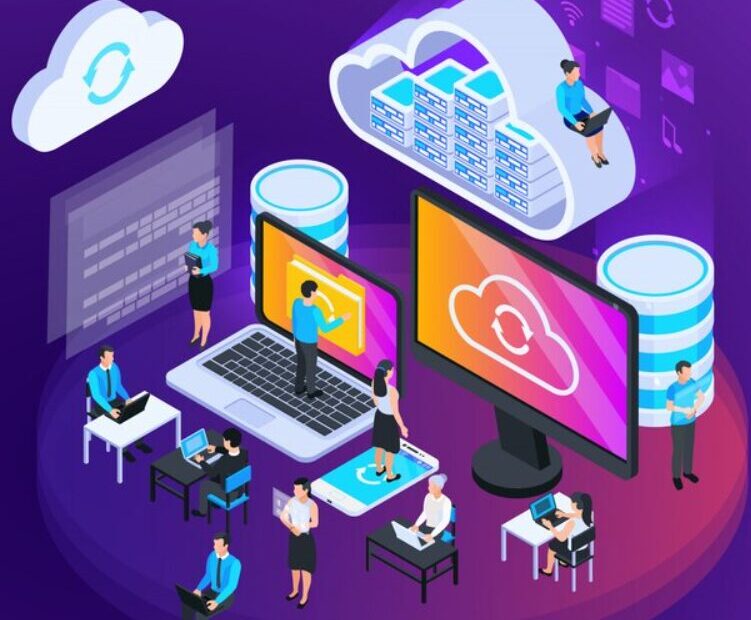Cloud computing has quickly become a popular term you might hear at work, in coffee shops, or even when talking with friends over dinner. But if you’re not someone who knows a lot about technology, this term might seem a bit confusing or hard to understand. This article is here to help explain cloud computing in the easiest way possible, making it clearer for everyone, no matter how much they know about tech.
Enozom is a software development company that exemplifies how businesses can leverage cloud computing to drive innovation and efficiency. Specializing in creating customized software solutions, Enozom utilizes cloud computing to offer scalable, flexible, and cost-effective services to its clients. By harnessing the power of the cloud, Enozom can develop, test, and deploy applications faster than ever before, ensuring that its products are not only cutting-edge but also reliable and secure.
Cloud computing enables Enozom to provide its clients with access to the latest technologies without the need for significant upfront investments in hardware or software. This approach not only reduces the time to market for new applications but also allows for easy updates and maintenance, ensuring that businesses always have access to the most advanced features.
What is Cloud Computing?
Imagine you have a closet full of clothes. You can access these clothes anytime you want, mix and match them according to your needs, and even lend them to friends. Now, imagine if this closet is not in your home but somewhere else, and you could access it anytime, anywhere, as long as you have an internet connection. This is cloud computing in a nutshell: storing and accessing data and programs over the internet instead of your computer’s hard drive.
The Three Main Types of Cloud Services
- Infrastructure as a Service (IaaS): This is like renting the land to build your house. You get the basic infrastructure – storage space, networks, and virtual servers – and have the freedom to build whatever you want on it.
- Platform as a Service (PaaS): This is akin to leasing a plot with the foundation already laid out for you. It’s perfect for developers who want to create applications without worrying about underlying infrastructure.
- Software as a Service (SaaS): Imagine renting a fully furnished apartment. SaaS offers you complete software solutions that you can use right away, like email services, customer relationship management (CRM) systems, and more, all hosted on the cloud.
Why Use Cloud Computing?
- Cost Efficiency: It reduces the need for purchasing hardware and software, setting up and running on-site datacenters, the electricity for power and cooling, and IT experts for managing the infrastructure. It’s more about renting than owning.
- Scale with Ease: Depending on your needs, you can scale up or down your cloud capacity, much like adjusting your data plan based on your usage.
- Performance and Speed: Cloud services run on worldwide networks of secure data centers, which are regularly upgraded to the latest generation of fast and efficient computing hardware.
- Security and Reliability: Cloud computing makes data backup, disaster recovery, and business continuity easier and less expensive because data can be mirrored at multiple redundant sites on the cloud provider’s network.
Real-World Examples
- Streaming Services: When you watch a movie on Netflix, you’re using cloud computing. The content is stored in the cloud, allowing you to access it anytime, anywhere.
- Email and Office Tools: Services like Gmail or Microsoft Office 365 operate in the cloud, enabling you to use them through any web browser without needing to install anything on your computer.
How to Approach Cloud Computing
If you’re considering cloud computing for personal use or for your business, start by identifying what you need. Do you need a place to store your photos and documents (cloud storage), or are you looking to host a website or application (IaaS)? Maybe you’re interested in using software online without installing it (SaaS). Once you’ve identified your needs, you can explore the cloud services that best fit those requirements.
Conclusion
Cloud computing is not just a technical jargon; it’s a revolution that has democratized computing power, making it accessible and affordable for everyone. By understanding its basics, types, benefits, and applications, even non-techies can appreciate the cloud’s value and how it impacts our daily lives, both personally and professionally. Whether you’re a business owner, a student, or just someone curious about technology, embracing the cloud can open up a world of possibilities.
